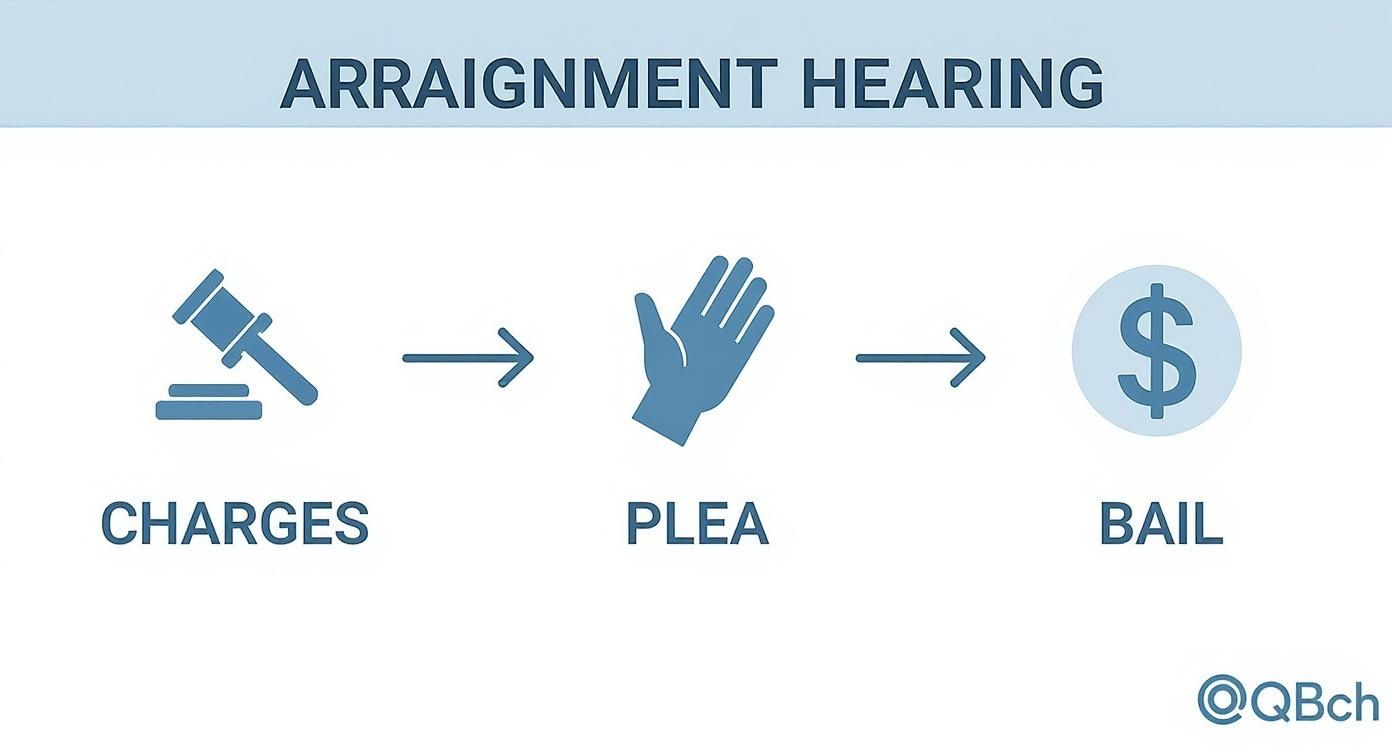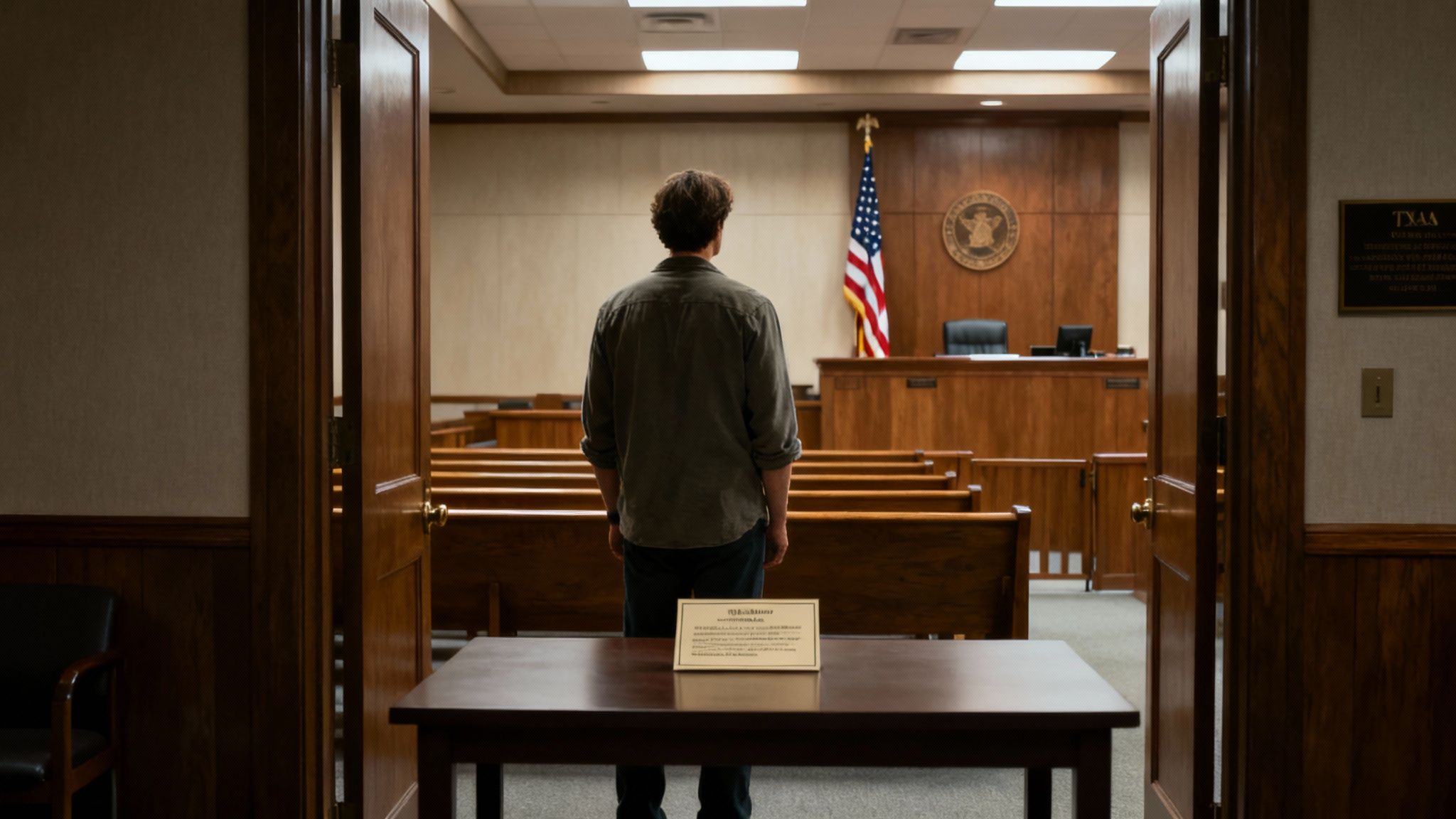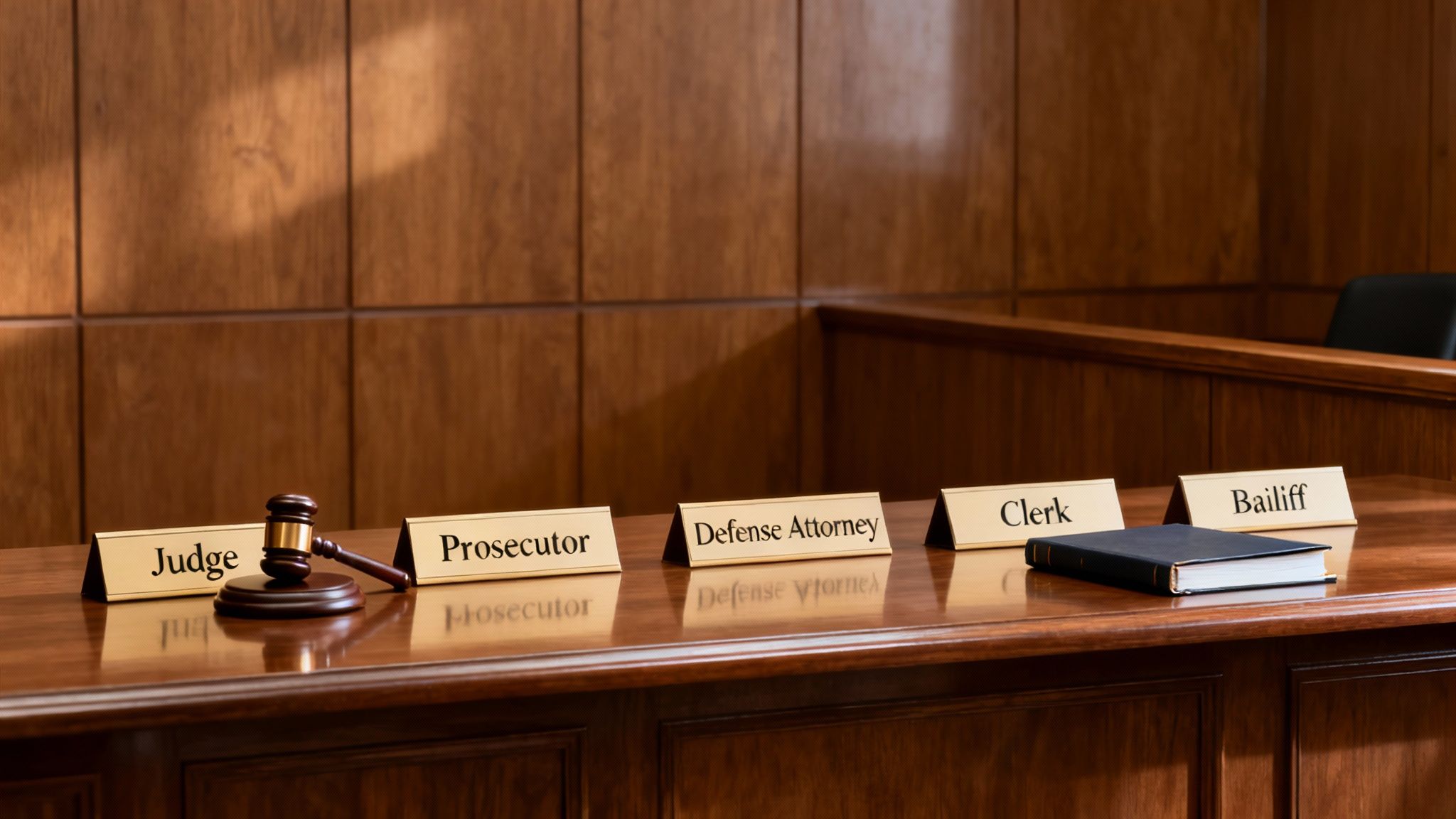Being arrested in Texas can be a terrifying and confusing experience, but you don’t have to face it alone. The first major stop in the court process is your arraignment hearing, which serves as the formal kickoff for your case. In a nutshell, at an arraignment hearing, the judge officially reads the criminal charges filed against you, makes sure you have a lawyer, asks for your plea, and sets your bail and any conditions for your release. It's a critical first step, and understanding what happens can help you feel more in control.
Your First Day in Court: What Is an Arraignment?
Think of the arraignment as the official start of the legal battle ahead. Before this hearing, you’ve been arrested and booked, but this is the first time your case is actually presented in a formal courtroom. It's a critical moment that lays the groundwork for your entire defense.
The primary goal here is to make sure you understand your rights and the exact accusations you're facing. The judge will confirm you are aware of:
- The Specific Charges: Whether you're facing a misdemeanor like a first-time DWI, assault, theft, or drug possession, the court must state the exact Texas Penal Code section you are accused of violating.
- Your Right to an Attorney: The judge will ask if you have a lawyer. If you cannot afford one, the court is required to appoint one for you.
- Your Plea: You will be asked to enter a plea—typically "guilty," "not guilty," or "no contest."
This infographic gives you a quick visual of the three main events that happen during an arraignment hearing.

The flow from the reading of the charges to your plea and then the bail decision sets the stage for everything that follows in your case.
A Step-by-Step Look at Your Arraignment Hearing
To make things clearer, here’s a simple table that breaks down the key events during a typical Texas arraignment. Knowing what to expect can help you feel more prepared and less anxious when you walk into the courtroom.
| Event in Court | What This Means for You |
|---|---|
| Case is Called | The judge or clerk calls your name and case number. You (and your lawyer) will approach the judge's bench or a designated podium. |
| Charges Are Read | The judge will formally read the criminal complaint against you, stating the exact law you are accused of breaking. This isn't a trial—it's just a formal notice. |
| Rights Are Explained | The judge will inform you of your constitutional rights, including your right to remain silent and your right to an attorney. |
| Plea is Entered | You will be asked how you plead to the charges. In most cases, your lawyer will advise you to plead "not guilty" at this stage. |
| Bail is Determined | The judge will decide on bail and any pretrial release conditions. They will consider factors like your criminal history and ties to the community. |
| Next Court Date is Set | Finally, the judge will schedule your next court appearance, which could be a pretrial conference or another hearing. |
This step-by-step process is fairly standard, though the specifics can vary slightly depending on the court and the nature of your case.
Bail and Pretrial Release Decisions
One of the most stressful parts of an arraignment is the judge's decision on bail, as it determines whether you can go home while your case moves forward. Unfortunately, many judges rely heavily on cash bail. One study observed that bail was set in 68% of cases, while only 21% of defendants were released on their own recognizance (without having to post money).
This heavy reliance on cash bail often leads to pretrial detention for people who simply can't afford to pay.
A formal record of everything said during your arraignment is typically created. You can learn more about how courts document these proceedings through legal transcription services. Understanding each step of this crucial hearing is the first line of defense in protecting your freedom.
Who You Will See in the Courtroom

Walking into a Texas courtroom for the first time can feel like stepping onto a stage where you don't know the script. It's easy to feel overwhelmed, but once you understand who’s who, the entire process becomes much less intimidating.
Each person in that room has a specific job to do. When you cut through the legal jargon and formal titles, you’ll quickly realize that only one of them is there exclusively to fight for you: your defense attorney.
Key Courtroom Participants
During your arraignment, you'll see a few main players. Here’s a quick rundown of their roles:
- The Judge: Think of the judge as the referee. They preside over the hearing, make sure everyone follows the rules, officially read the charges against you, and make crucial decisions about things like your bail.
- The Prosecutor: This is the attorney representing the State of Texas. Their one and only goal is to build a case against you and secure a conviction. They are not on your side.
- Your Defense Attorney: This is your advocate, your guide, and your shield. Their entire purpose is to protect your rights, challenge the prosecutor's narrative, and navigate you through every step of the legal maze.
- The Court Clerk: The clerk is the official record-keeper. They manage all the court’s paperwork and document every single thing that happens during the hearing, creating the official case file.
- The Bailiff: This is a law enforcement officer whose job is to keep the courtroom secure and maintain order.
Having an experienced criminal defense lawyer in your corner from day one is absolutely essential. While the court will appoint a public defender if you can't afford a private attorney, it's worth understanding the differences between a public defender vs. a private attorney. Your lawyer is the one person who ensures your voice is heard and your rights are protected from the very start.
Understanding Your Constitutional Rights

An arraignment isn't just another court date to check off the list. It’s a critical moment where your constitutional rights come alive, setting the tone for your entire defense strategy.
Think of it as the foundation of your case. Knowing what protections you’re guaranteed under the law gives you and your attorney the power to start challenging the prosecution's claims from day one.
Your Right to an Attorney
Without a doubt, the most important right at this stage is the Right to Counsel. This means you're entitled to have a lawyer standing beside you through every step of the criminal process. The judge will ask if you have an attorney, and if you can't afford one, the court is legally required to appoint one for you.
Having an experienced Houston criminal lawyer with you isn't just a good idea—it's your first line of defense. Your attorney acts as your shield, making sure your other rights are respected and preventing you from accidentally saying something that could seriously hurt your case.
Knowing the Charges Against You
You also have the Right to be Informed of the Charges. The court can’t just move forward on a vague accusation; you must be formally told exactly what crime the State of Texas is accusing you of committing under the Texas Penal Code.
The prosecutor must state the specific charges, whether it's a misdemeanor drug possession case or a complex felony theft allegation. This formal notice is what allows your defense team to start building a strategy tailored to fight the specific claims you're up against.
Your arraignment is where the legal shield of the Constitution is formally raised. Pleading 'not guilty' is the key that unlocks these protections, giving your defense attorney the time and opportunity to build the strongest case possible on your behalf.
The Right to Remain Silent
Finally, there’s the fundamental Right to Remain Silent, protected by the Fifth Amendment. This means you can never be forced to say anything that might incriminate yourself. When you plead "not guilty" at your arraignment, you are actively exercising this powerful right.
That plea isn't a lie; it’s a legal tool. It puts the ball back in the State of Texas's court, forcing them to prove every element of their case against you beyond a reasonable doubt. Entering a "not guilty" plea keeps all your options open and is almost always the right strategic move.
How to Navigate the Three Plea Options
One of the most intense moments in an arraignment hearing is when the judge turns to you and asks, "How do you plead?" This isn't just a procedural question—your answer sets the entire trajectory for your case. In Texas, you have three choices, and knowing what they mean is non-negotiable.
The decision you make right then and there has immediate and lasting consequences for your freedom. While a good lawyer will guide you, it's critical that you understand what's at stake with each option.
Your Three Choices Explained
When you're standing before the judge, you can enter one of three pleas. Each one sends your case down a completely different path.
-
Guilty: This is a full admission that you committed the crime. Pleading guilty at arraignment means you’re giving up nearly all of your rights, including the right to a trial. The case skips straight to sentencing. This is almost never the right move this early on.
-
Not Guilty: This isn't about lying or denying facts. It's a formal legal statement that forces the State of Texas to prove its case against you beyond a reasonable doubt. Entering this plea preserves all of your constitutional rights and gives your attorney the breathing room needed to review evidence, find weaknesses, and build a defense.
-
Nolo Contendere (No Contest): This plea is a bit of a hybrid. You aren't admitting guilt, but you're also not fighting the charges. The court will find you guilty anyway and move to sentencing. While it functions like a guilty plea in criminal court, it typically can't be used against you as an admission of fault in a separate civil lawsuit. For a deeper dive, you can learn more by understanding the differences between guilty and no contest pleas.
To make this crystal clear, let's break down how these choices stack up side-by-side.
Comparing Your Plea Options at Arraignment
Understand the legal implications of pleading guilty, not guilty, or no contest at your first hearing.
| Plea Option | What It Legally Means | Immediate Court Outcome | Why It Matters for Your Case |
|---|---|---|---|
| Guilty | You are formally admitting you committed the crime as charged. | The case moves directly to sentencing. You give up most rights. | You lose all leverage. There is no opportunity to review evidence or negotiate. |
| Not Guilty | You are exercising your right to make the State prove its case against you. | The case proceeds. Your attorney can now gather evidence and build a defense. | This is the only plea that preserves all your options, including a trial or a better plea deal later. |
| No Contest | You are not admitting guilt but will accept the conviction and punishment. | The case moves directly to sentencing, just like a guilty plea. | It protects you in potential civil lawsuits but otherwise functions as a guilty plea in the criminal case. |
Thinking through this table makes the best strategic move pretty obvious for this stage of the game.
The strategic choice in almost every single case is to plead "not guilty." This plea is your key to unlocking the entire legal process. It gives your defense team the crucial time to investigate, challenge the prosecutor's evidence, and fight for the best possible outcome—whether that’s a dismissal, a favorable plea deal, or an acquittal at trial.
Navigating Bail and Pretrial Release
For most people sitting in a Texas courtroom for their arraignment, the biggest question on their mind is, "Am I going home today?" This is the moment the judge decides on bail and sets the rules for your pretrial release—a decision that will shape your entire life while the case moves forward.
The judge's main job here is to make sure you'll show up for your future court dates. To do that, they have to weigh several key factors to figure out if you're a flight risk or a potential danger to the community.
How Judges Decide on Bail
In Texas, judges have a lot of leeway when setting bail. They’ll look closely at the specifics of your situation and the charges you're facing.
- The Severity of the Charge: A serious felony like aggravated assault is going to come with a much higher bail amount than a misdemeanor theft charge under the Texas Penal Code.
- Your Criminal History: If you have prior convictions or a history of skipping court dates, the judge will see you as a much bigger risk.
- Your Ties to the Community: Do you have a steady job? Is your family here? Have you lived in the area for a long time? Strong community connections signal to the judge that you’re not likely to just disappear.
This is where an experienced Texas criminal defense attorney becomes your most important advocate. We can present evidence showing you're reliable and argue for the lowest possible bail—or even for a release on your own recognizance (a "personal bond").
Understanding Different Types of Bonds
There are a few different ways to get out of jail in Texas, and it's critical to know what your options are. You can get a full breakdown in our guide on how bail and bonds work in Texas.
The use of money bail has become increasingly common across the country. National data reveals that the proportion of felony cases where money bail was set rose from 53% in 1990 to 70% by 2006, leading to higher rates of people being held in jail simply because they can't afford to pay. Learn more about these pretrial detention trends.
Beyond just setting a dollar amount, the judge will also establish pretrial release conditions. Think of these as the ground rules you have to follow to stay out of jail. Common conditions include no-contact orders, regular check-ins with a probation officer, or even GPS monitoring. If you break any of these rules, your bond can be revoked, and a warrant will be issued for your re-arrest.
What Happens After Your Arraignment Hearing?

Think of your arraignment hearing as the starting gun, not the finish line. Once you’ve entered a "not guilty" plea and the judge has laid out your bond conditions, your case officially enters the pretrial phase. This is where the real work of building your defense begins, from plea bargaining to potentially preparing for trial and sentencing.
This stage is a marathon, not a sprint. It’s a series of strategic moves your criminal defense lawyer will make to poke holes in the prosecution’s evidence and fiercely protect your rights.
The Pretrial and Discovery Phase
The period between your arraignment and a potential trial is known as the pretrial phase. A huge part of this is discovery, a formal legal process where your attorney demands and receives every piece of evidence the prosecutor has against you.
This isn't just a friendly exchange of notes. We’re talking about a formal request for everything the state plans to use, which can include:
- Police reports and the officers' handwritten notes
- Statements and interviews from any witnesses
- Body camera and dash cam footage
- Lab test results, like blood alcohol content in a DWI case
- Crime scene photographs
During this critical time, it’s absolutely essential to stay in close contact with your legal team and follow every single one of your bond conditions. Once discovery is complete, the journey continues with motions, negotiations, and, if necessary, a trial. This is where your attorney takes the evidence gathered and starts preparing for trial by filing pretrial motions to exclude evidence, negotiating with the prosecutor, and mapping out a powerful defense strategy.
Common Questions About Texas Arraignments
Navigating the criminal justice system for the first time brings up a ton of questions. It’s completely normal to feel uncertain about what’s coming next. Below, we’ve put together some clear, straightforward answers to the most common concerns people have about arraignment hearings in Texas.
Can My Case Get Dismissed at the Arraignment Hearing?
It's extremely rare for a judge to dismiss a case at the arraignment itself. Think of this hearing as the official kickoff for the legal process, not the finish line. Its main purpose is to get the case formally started.
However, the arraignment is the first real chance for your Texas assault defense attorney to get a look at the charges and spot any obvious weaknesses. A dismissal is far more likely to happen later on, usually during pretrial motions after your lawyer has had time to dig into the evidence. Pleading "not guilty" is what buys you the time and opportunity to build that case for dismissal.
What Is the Best Way to Dress for My Arraignment?
You should dress like you're heading to a serious job interview. It’s a simple but powerful way to show the judge and everyone else in the courtroom that you're taking this situation seriously.
Business casual is always a safe bet. That means no shorts, hats, sandals, or t-shirts with graphics. Your appearance creates an immediate first impression, and you want it to be a positive one—especially when a judge is about to make decisions affecting your freedom and bail conditions.
Will I Have to Speak Directly to the Judge?
Probably not, and you'll likely have to say very little. The judge might ask you to state your name for the record and confirm that you understand the rights they've just explained.
When it's time to enter your plea, your attorney will almost always handle it or advise you to simply say “not guilty.” Your lawyer's job is to do the talking and make sure you don't say anything that could accidentally hurt your case down the road. Under no circumstances should you ever answer questions about the facts of your case.
If you’ve been charged with a crime in Texas, call The Law Office of Bryan Fagan, PLLC for a free and confidential consultation. Our defense team is ready to protect your rights.

